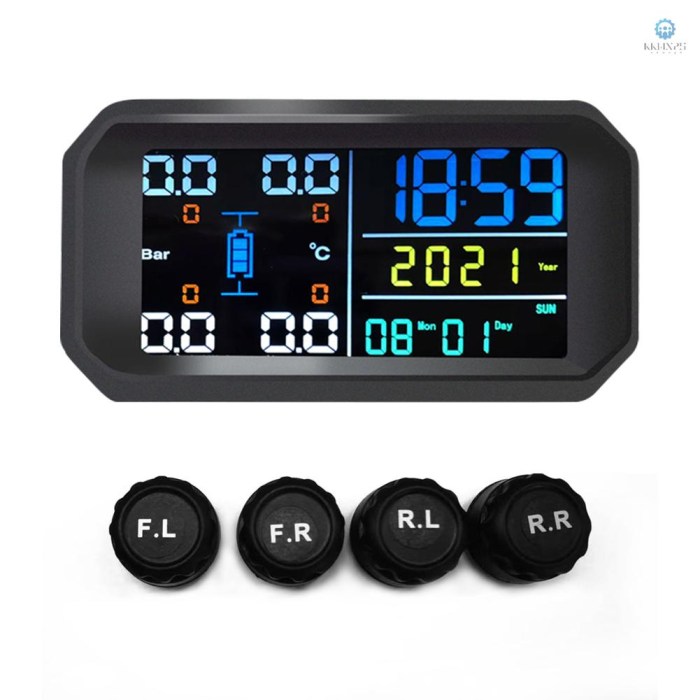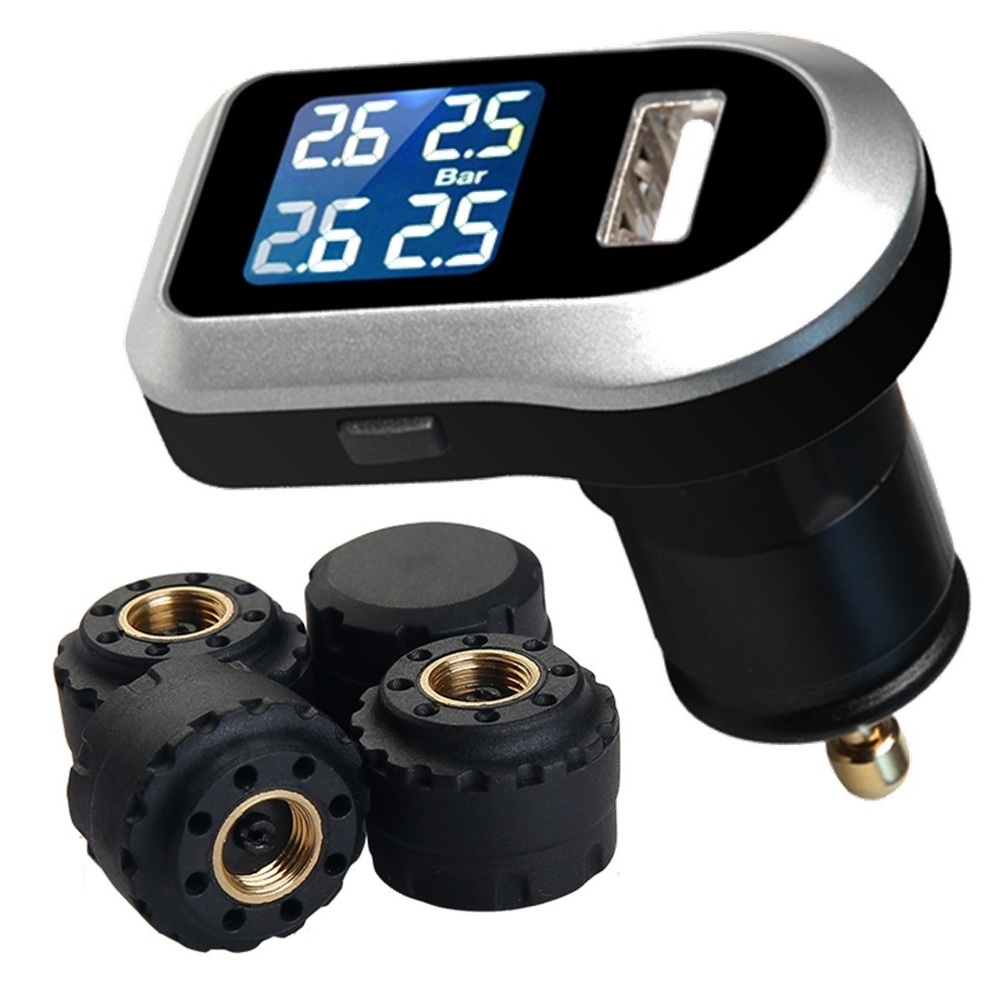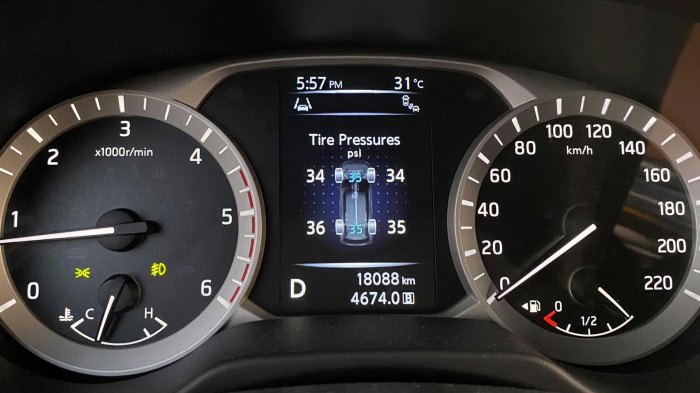EV tire pressure monitoring systems (TPMS) are way more crucial for electric vehicles than you might think. Think about it – EVs are heavier, have different tire constructions, and rely on regenerative braking, all of which can impact tire pressure. This means a reliable TPMS isn’t just a nice-to-have; it’s essential for safety and extending the life of your expensive tires.
We’ll explore the tech behind these systems, from sensor types to how they integrate with your car’s computer brain, and even look at future trends. Get ready to become a TPMS pro!
We’ll cover the different types of TPMS technologies, how they handle the unique challenges of EVs (like regenerative braking and those hefty batteries), and how the system alerts you to problems. We’ll also discuss maintenance, future advancements, and answer some common questions you might have about keeping your EV tires properly inflated.
EV Tire Pressure Monitoring System (TPMS) Technologies
Electric vehicles (EVs), with their focus on efficiency and safety, rely heavily on advanced tire pressure monitoring systems (TPMS). These systems are crucial for optimizing range, handling, and preventing tire-related accidents. Understanding the different TPMS technologies employed in EVs is vital for both manufacturers and consumers.
Direct and Indirect TPMS Technologies in EVs
EVs utilize both direct and indirect TPMS technologies, each with its own strengths and weaknesses. Direct TPMS uses individual pressure sensors within each tire, transmitting data wirelessly to the vehicle’s onboard computer. Indirect TPMS, conversely, infers tire pressure by monitoring wheel speed variations using the Anti-lock Braking System (ABS) sensors. Direct systems offer higher accuracy and the ability to detect slow leaks, while indirect systems are simpler and less expensive to implement, although less precise and less sensitive to slow leaks.
The choice between these systems often depends on cost considerations and the desired level of accuracy.
Sensor Placement and Functionality in Different EV Tire Designs
Sensor placement varies depending on the tire design and the type of TPMS used. In direct TPMS, sensors are typically integrated into the valve stem or mounted within the tire itself. For EVs with low-profile tires or specialized wheel designs, the sensor integration can become more complex, requiring careful consideration of sensor size and placement to avoid interference with other components.
The functionality remains consistent across designs: the sensor measures pressure and temperature, transmitting this data wirelessly to the vehicle’s central unit.
EV tire pressure monitoring systems are crucial for safety and efficiency, but imagine seeing that data overlaid directly onto your dashboard! Check out this article on Augmented reality dashboards in 2025 EVs to see how this tech could change the game. Then, think about how seamlessly integrated tire pressure info, among other vital stats, would improve the driver experience even further.
It’s all about making EVs even smarter.
Communication Protocols Used in EV TPMS
Several communication protocols facilitate data transmission from the TPMS sensors to the vehicle’s onboard computer. Bluetooth is becoming increasingly popular due to its low power consumption and relatively long range. Radio Frequency (RF) communication is another common method, offering a robust and reliable connection, though it might require more power. The specific protocol used often depends on the manufacturer and the overall vehicle architecture.
Some systems might even employ a hybrid approach, combining different protocols for redundancy or improved performance.
Comparison of TPMS Technologies
| Feature | Direct TPMS | Indirect TPMS | Hybrid TPMS |
|---|---|---|---|
| Accuracy | High | Moderate | High |
| Cost | Higher | Lower | Moderate |
| Leak Detection | Excellent (slow leaks detectable) | Poor (detects only significant pressure drops) | Excellent |
| Complexity | Higher | Lower | Moderate |
| Maintenance | Requires sensor battery replacement | Generally low maintenance | Requires sensor battery replacement (for direct component) |
Integration with EV’s Electrical System
Integrating a Tire Pressure Monitoring System (TPMS) into an electric vehicle (EV) requires careful consideration of power consumption and seamless communication with the vehicle’s existing electrical architecture. The system must reliably monitor tire pressure without significantly impacting the EV’s overall energy efficiency, and it needs to integrate smoothly with the central control unit (ECU) for alert generation and display.TPMS power consumption varies significantly depending on the technology employed.
Direct-sensor systems, which transmit data wirelessly, generally consume less power than indirect systems relying on wheel speed sensors. Low-power wireless protocols like Bluetooth Low Energy (BLE) are often preferred to minimize drain on the EV’s battery. For example, a BLE-based system might consume only a few microwatts in standby mode and a few milliwatts during active transmission, a negligible amount compared to the EV’s overall energy usage.
In contrast, systems relying on older, less power-efficient technologies might consume significantly more energy, impacting the EV’s range. Battery life of the sensors themselves is also a critical design factor, with manufacturers aiming for several years of operation without replacement.
TPMS Integration with the EV’s Central Control Unit (ECU)
The TPMS integrates with the EV’s ECU via a communication bus, typically CAN (Controller Area Network) or LIN (Local Interconnect Network). The sensors transmit pressure data wirelessly to a receiver unit, often located near the ECU. This receiver then processes the data and forwards it to the ECU over the vehicle’s communication bus. The ECU, acting as the central brain of the EV, receives this information, compares it to pre-set thresholds, and triggers alerts if necessary.
The communication protocol ensures reliable data transfer and error checking to prevent false alarms or missed warnings. The ECU’s software also manages the TPMS data alongside other vehicle systems, prioritizing alerts based on their severity.
TPMS Data Transmission and Processing
Data transmission involves the sensors periodically sending pressure and temperature readings to the receiver unit. These readings are then processed to account for factors such as temperature variations that affect tire pressure. The receiver performs signal processing and error correction before forwarding the data to the ECU. The ECU utilizes sophisticated algorithms to analyze the received data, comparing it against pre-programmed thresholds for low pressure, rapid pressure loss, and sensor malfunctions.
If a critical condition is detected, the ECU generates an appropriate alert, such as a visual warning on the driver’s display and potentially an audible alarm. The system also incorporates self-diagnostic capabilities to detect sensor failures and alert the driver accordingly.
Simplified Block Diagram of TPMS Data Flow
Imagine a simple block diagram. First, we have the TPMS sensors in each wheel, each sending data wirelessly. These signals converge at a receiver unit, which then transmits the processed data via the CAN bus to the ECU. The ECU processes this data and sends a signal to the driver’s instrument cluster display, showing the tire pressures and any warnings.
This visual representation provides a clear picture of the information flow, highlighting the key components and their interactions within the EV’s system. The diagram clearly shows the flow of information from sensors, through processing units, to the final driver display, providing a straightforward understanding of the system architecture.
Impact of EV Specific Factors on TPMS
Electric vehicles (EVs), with their unique powertrain and design characteristics, present some interesting challenges for Tire Pressure Monitoring Systems (TPMS). Unlike traditional internal combustion engine (ICE) vehicles, EVs introduce factors that can affect TPMS accuracy and reliability. Understanding these factors is crucial for developing robust and accurate TPMS for the next generation of EVs.Regenerative braking, electric motor torque, battery weight distribution, and variations in tire construction all play a significant role in influencing TPMS readings.
EV tire pressure monitoring systems are becoming increasingly sophisticated, using sensors and algorithms to optimize fuel efficiency and safety. This is all part of a larger trend, as discussed in this article on the Impact of AI on EV manufacturing 2025 , where AI is revolutionizing manufacturing processes. Ultimately, these advancements, from AI-driven design to improved sensor technology, will lead to even better EV tire pressure monitoring systems in the future.
Let’s delve into each of these factors and explore their impact.
Regenerative Braking’s Effect on TPMS Accuracy
Regenerative braking, a key feature of EVs, converts kinetic energy into electrical energy during deceleration, thereby recharging the battery. This process can induce small, yet potentially measurable, changes in tire pressure due to the braking forces applied to the wheels. These pressure fluctuations can be misinterpreted by the TPMS as actual pressure changes, potentially leading to inaccurate readings or false alarms.
The intensity of this effect depends on the regenerative braking strategy employed and the vehicle’s driving style. For instance, aggressive regenerative braking might cause more significant pressure variations than a gentler approach. Sophisticated TPMS algorithms are being developed to filter out these transient pressure changes caused by regenerative braking, improving overall accuracy.
Electric Motor Torque’s Influence on Tire Pressure Fluctuations
The high torque output of electric motors, especially at low speeds, can also subtly affect tire pressure. The instantaneous application and release of torque can create minor pressure fluctuations within the tires. While individually these fluctuations are small, their cumulative effect over time could potentially influence the average pressure reading perceived by the TPMS. The impact is likely more pronounced in EVs with higher torque outputs and aggressive acceleration profiles.
Again, advanced TPMS algorithms are designed to account for these subtle variations, distinguishing them from actual pressure leaks or changes.
Battery Weight and Distribution’s Impact on TPMS Readings
The substantial weight of EV batteries and their location within the vehicle significantly impact the overall weight distribution. This uneven weight distribution can influence tire pressure, especially under different loading conditions. A heavier battery pack concentrated in the vehicle’s floor might result in higher pressure in the rear tires compared to the front, particularly during cornering or acceleration.
The TPMS must be calibrated to account for this inherent weight imbalance, ensuring accurate pressure readings across all tires regardless of the vehicle’s load distribution. Manufacturers often use sophisticated models of vehicle dynamics and weight distribution to compensate for this factor.
Variations in Tire Construction for EVs and their Effect on TPMS Performance
EVs often utilize specialized tires designed to optimize energy efficiency and range. These tires may have different constructions, materials, and sidewall stiffness compared to traditional ICE vehicle tires. These variations can affect how the tire interacts with the TPMS sensor, potentially influencing signal strength or accuracy. For example, tires with thicker sidewalls might slightly dampen pressure fluctuations, making it harder for the TPMS to detect small changes.
Tire manufacturers and TPMS developers must collaborate to ensure compatibility and maintain accuracy across various tire constructions used in EVs. This necessitates rigorous testing and calibration procedures to guarantee reliable performance under different tire configurations.
TPMS Alerts and Driver Interface: EV Tire Pressure Monitoring Systems

Getting that low tire pressure warning is never fun, but in EVs, the way these alerts are presented is crucial for both safety and the overall driving experience. Effective communication is key, especially since EVs often rely more heavily on sophisticated electronics for various functions. We’ll explore the different ways drivers are notified about tire pressure issues in their electric vehicles, the design considerations behind those alerts, and how these systems work with other EV features.
EV TPMS systems employ a variety of methods to inform drivers about low tire pressure. These range from simple visual indicators on the dashboard to more sophisticated auditory alerts and integration with other driver-assistance features. The design of these alerts needs to be intuitive and unambiguous, ensuring that drivers understand the severity of the situation and can take appropriate action.
Methods of Alerting Drivers to Low Tire Pressure
EVs use a combination of visual and audible alerts to notify drivers of low tire pressure. Visual alerts typically involve a warning light on the instrument cluster, often accompanied by a textual message specifying which tire(s) is affected and the severity of the pressure drop. Audible alerts, usually a distinct chime or beep, add another layer of immediacy, especially in noisy environments or when the driver’s attention might be diverted.
Some systems also incorporate haptic feedback, such as vibrations in the steering wheel, to further enhance the alert’s impact. For instance, a Tesla might use a visual warning on the touchscreen, a chime, and even a notification sent to the driver’s smartphone app.
Design Considerations for Visual and Audible Alerts
The design of these alerts requires careful consideration of several factors. Visual alerts need to be easily discernible against the dashboard’s background, even in bright sunlight. The font size and style of textual messages should be clear and legible, even from a distance. Audible alerts should be distinct enough to be heard over the ambient noise within the vehicle, yet not overly jarring or annoying.
The frequency and duration of the alerts should also be carefully calibrated to avoid driver fatigue or annoyance, while ensuring the message is adequately conveyed. For example, a persistent low-frequency hum might be less distracting than a repetitive, high-pitched beep.
Integration with Other EV Driver Assistance Systems
Modern EVs often boast advanced driver-assistance systems (ADAS). TPMS alerts can be intelligently integrated with these systems. For instance, a TPMS alert could trigger a reduction in the vehicle’s maximum speed or a suggestion to pull over safely to address the low tire pressure. This integration promotes safer driving practices and helps drivers respond proactively to potential tire-related issues.
Imagine a scenario where the navigation system suggests the nearest gas station with an air pump after receiving a low-pressure alert.
Best Practices for Designing User-Friendly TPMS Alerts in an EV
Designing effective TPMS alerts requires a user-centered approach. Here are some best practices:
Effective alert design hinges on clear communication and seamless integration. The following points highlight key considerations for creating user-friendly TPMS alerts in EVs:
- Clear and concise messaging: Avoid technical jargon and use plain language to communicate the issue.
- Consistent visual cues: Use standardized symbols and colors for different alert levels (e.g., yellow for warning, red for critical).
- Appropriate auditory signals: Choose alert sounds that are distinct, audible, and not easily ignored but avoid sounds that are overly jarring or annoying.
- Multi-modal alerts: Combine visual and auditory cues for greater impact and reach drivers in diverse situations.
- Contextual information: Provide details about the affected tire(s) and the severity of the pressure drop.
- Integration with other systems: Seamlessly integrate TPMS alerts with other driver-assistance features for enhanced safety and convenience.
- Customization options: Allow drivers to adjust alert settings (e.g., volume, sensitivity) based on their preferences.
Maintenance and Calibration of EV TPMS
Keeping your EV’s TPMS (Tire Pressure Monitoring System) in top shape is crucial for safety and optimal tire performance. Regular maintenance and occasional calibration ensure accurate pressure readings, allowing you to proactively address potential issues and maximize your EV’s efficiency and lifespan. Neglecting your TPMS can lead to decreased tire life, reduced fuel efficiency (even in an EV, rolling resistance impacts range), and compromised safety.
TPMS Sensor Replacement and Recalibration Procedures, EV tire pressure monitoring systems
Replacing or recalibrating a TPMS sensor usually requires specialized tools and, often, a visit to a tire shop or qualified mechanic. The process varies slightly depending on the EV make and model, but the general principles remain consistent. Improper handling can damage the sensor or the wheel, so professional assistance is recommended.
Tire Rotation’s Impact on TPMS Readings
Tire rotation, a standard maintenance practice, directly impacts TPMS readings because each sensor is uniquely identified and associated with a specific wheel position. Rotating tires necessitates recalibration. Failure to do so results in inaccurate pressure readings, potentially triggering false alerts or failing to alert you to a genuine pressure problem. For example, if you rotate your tires and don’t recalibrate the TPMS, the system might show the pressure of the rear left tire as being in the front right position, leading to confusion and potential safety hazards.
TPMS Sensor Failure and Diagnostic Methods
TPMS sensors, like any electronic component, are susceptible to failure. Factors such as age, physical damage, and battery depletion can all contribute to malfunction. Diagnostic methods typically involve using a scan tool that can communicate with the TPMS sensors, allowing technicians to identify malfunctioning sensors and assess their individual status (battery life, signal strength, etc.). A common symptom of sensor failure is a persistent TPMS warning light, even after adjusting tire pressure.
In some cases, the system might not even recognize a particular sensor.
EV TPMS Sensor Replacement: A Step-by-Step Guide
Replacing an EV TPMS sensor is a more involved process than a simple tire pressure check. It’s best left to professionals, but here’s a general Artikel of the steps involved:
- Preparation: Gather necessary tools (tire iron, jack, wheel chocks, torque wrench, new TPMS sensor). Consult your EV’s owner’s manual for specific torque specifications for your wheels.
- Secure the Vehicle: Safely jack up the vehicle and secure it with wheel chocks.
- Remove the Wheel: Loosen and remove the lug nuts, then carefully remove the wheel.
- Sensor Removal: Carefully remove the old TPMS sensor from the tire valve stem. This often involves unscrewing the sensor or using a specialized tool.
- Sensor Installation: Install the new TPMS sensor onto the valve stem, ensuring a secure and airtight connection.
- Wheel Reinstallation: Mount the wheel back onto the vehicle, ensuring it’s properly seated. Tighten the lug nuts to the manufacturer’s specified torque.
- Lower the Vehicle: Carefully lower the vehicle to the ground.
- TPMS Recalibration: Use a scan tool or follow your EV’s specific instructions to recalibrate the TPMS system. This usually involves driving a short distance to allow the system to learn the new sensor IDs.
Future Trends in EV TPMS

The evolution of electric vehicles (EVs) is inextricably linked to advancements in their supporting technologies. TPMS, crucial for safety and efficiency, is no exception. Future developments will focus on enhanced sensor capabilities, predictive maintenance integration, AI-driven functionalities, and sophisticated data analytics, all working together to create a more intelligent and reliable system.
Advancements in Sensor Technology
Next-generation EV TPMS will likely incorporate more sophisticated sensor technologies. For instance, we can expect to see a wider adoption of MEMS (Microelectromechanical Systems) sensors, known for their miniaturization, low power consumption, and improved accuracy compared to traditional piezoelectric sensors. Another promising area is the integration of multi-sensor systems, combining pressure and temperature sensors with acceleration and gyroscopic sensors to provide a more comprehensive picture of tire health and driving conditions.
This could lead to earlier detection of potential issues, such as tread wear or uneven pressure distribution, improving safety and extending tire lifespan. Imagine a system that not only detects low pressure but also anticipates potential punctures based on subtle vibrations detected by the integrated accelerometer.
Integration with Predictive Maintenance Systems
The integration of TPMS data with predictive maintenance systems offers significant potential. By analyzing TPMS data alongside other vehicle sensor data (like battery temperature, motor performance, and driving style), EV manufacturers can develop sophisticated algorithms to predict potential tire failures or the need for maintenance. This allows for proactive interventions, such as scheduling timely tire rotations or replacements, minimizing downtime and maximizing tire lifespan.
For example, an algorithm might predict a tire will need replacement within the next 1,000 miles based on pressure fluctuations, temperature data, and mileage, prompting a service alert to the driver.
Role of Artificial Intelligence in Enhancing EV TPMS Functionality
AI has the potential to revolutionize EV TPMS. Machine learning algorithms can be trained on vast datasets of TPMS data to identify subtle patterns indicative of tire problems that might be missed by traditional systems. This could lead to earlier detection of slow leaks, uneven wear, or other issues, improving safety and reducing the risk of accidents. Furthermore, AI could personalize TPMS alerts based on individual driving styles and environmental conditions, reducing the incidence of false alarms.
For instance, AI could differentiate between a genuine low-pressure condition and a temporary pressure drop due to a rapid temperature change.
Developments in Data Analytics for Improved Safety and Efficiency
Advanced data analytics will play a vital role in leveraging the information collected by EV TPMS. By analyzing aggregated TPMS data from a large fleet of EVs, manufacturers can identify trends and patterns related to tire performance and longevity under various driving conditions and climates. This data can inform tire design improvements, optimize tire pressure recommendations, and contribute to the development of more durable and efficient tires.
Furthermore, analyzing TPMS data in conjunction with road surface information could help optimize tire pressure for specific road conditions, improving fuel efficiency and reducing wear and tear. For example, a system could automatically adjust tire pressure based on real-time information about the road’s roughness or incline.
Last Recap

So, there you have it – a comprehensive look at EV tire pressure monitoring systems. From the intricate sensor technology and communication protocols to the user interface and future innovations, understanding TPMS is key to maximizing your EV’s performance and safety. Remember, properly inflated tires are not only about fuel efficiency (or in this case, energy efficiency!), but also about preventing accidents and extending the life of your tires.
Stay informed, stay safe, and keep those tires pumped!









